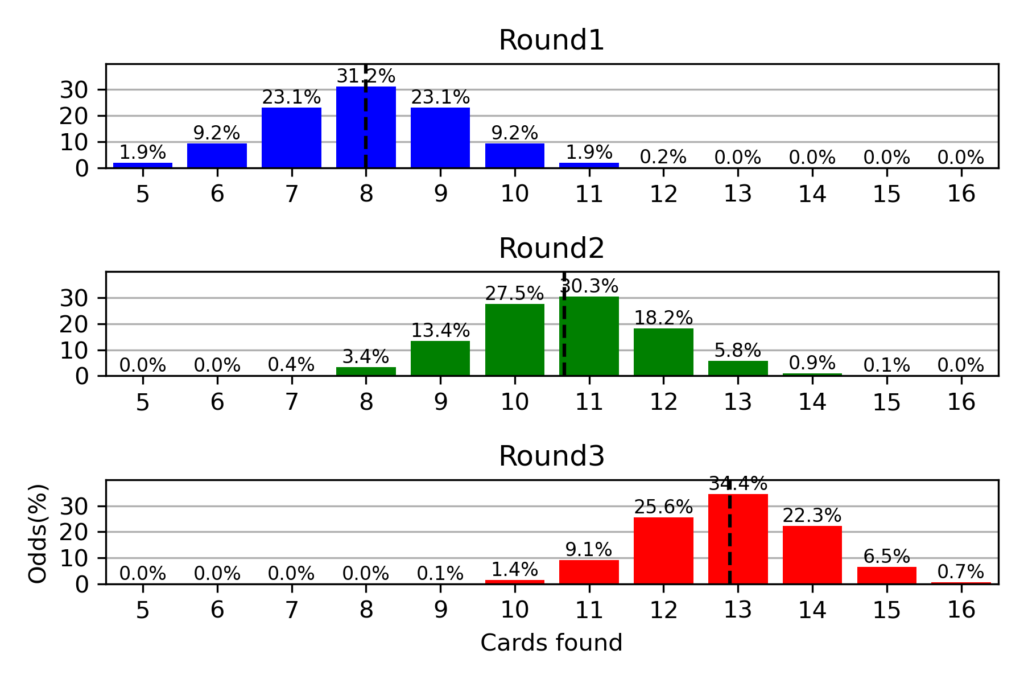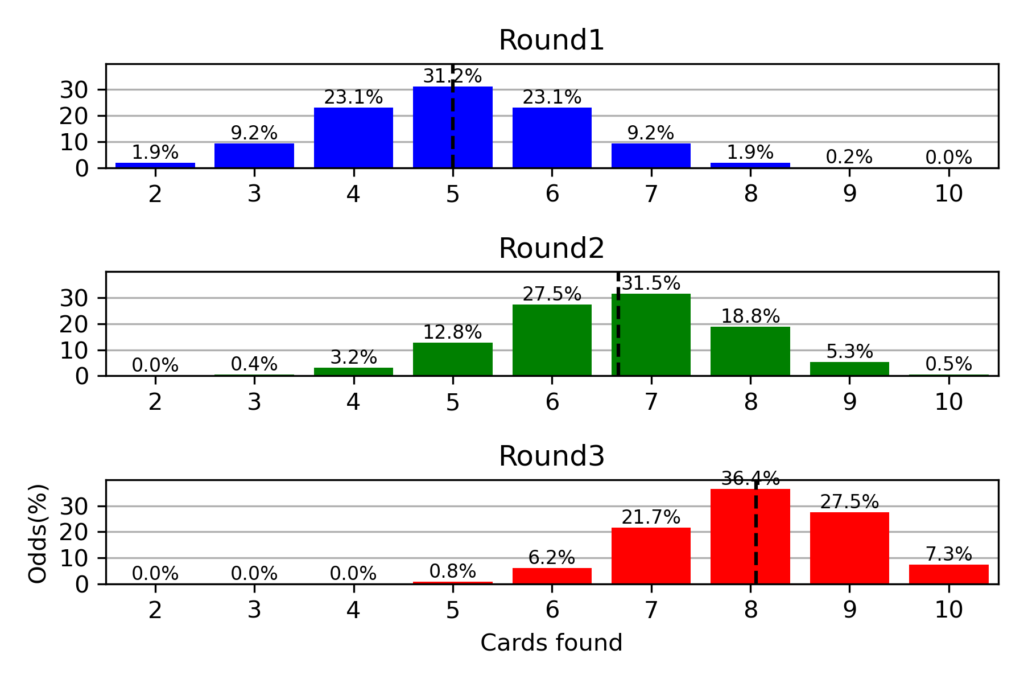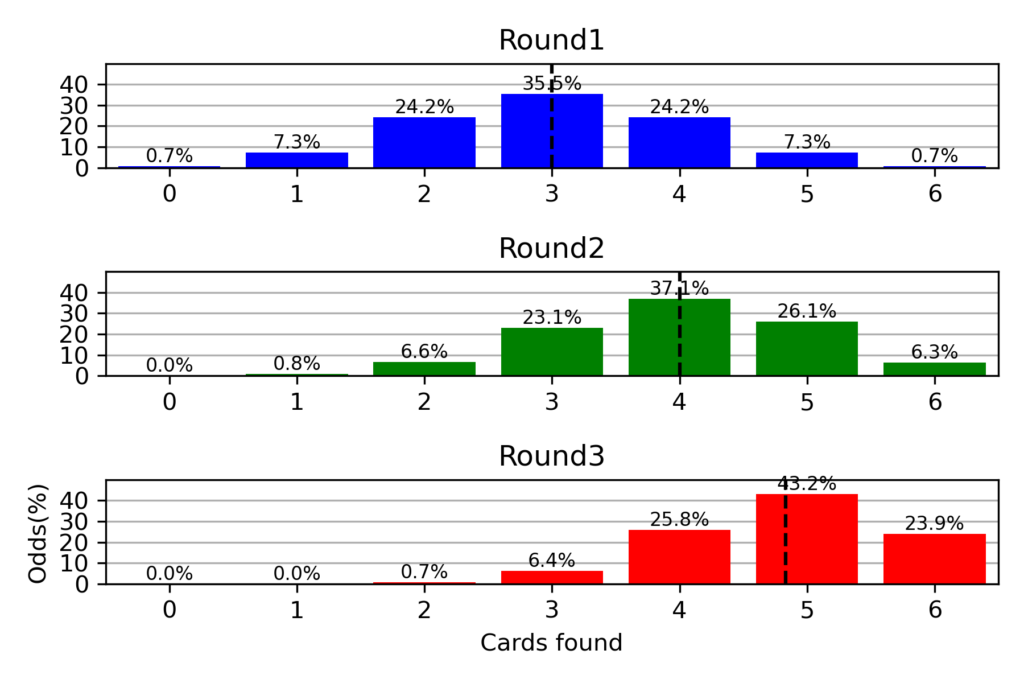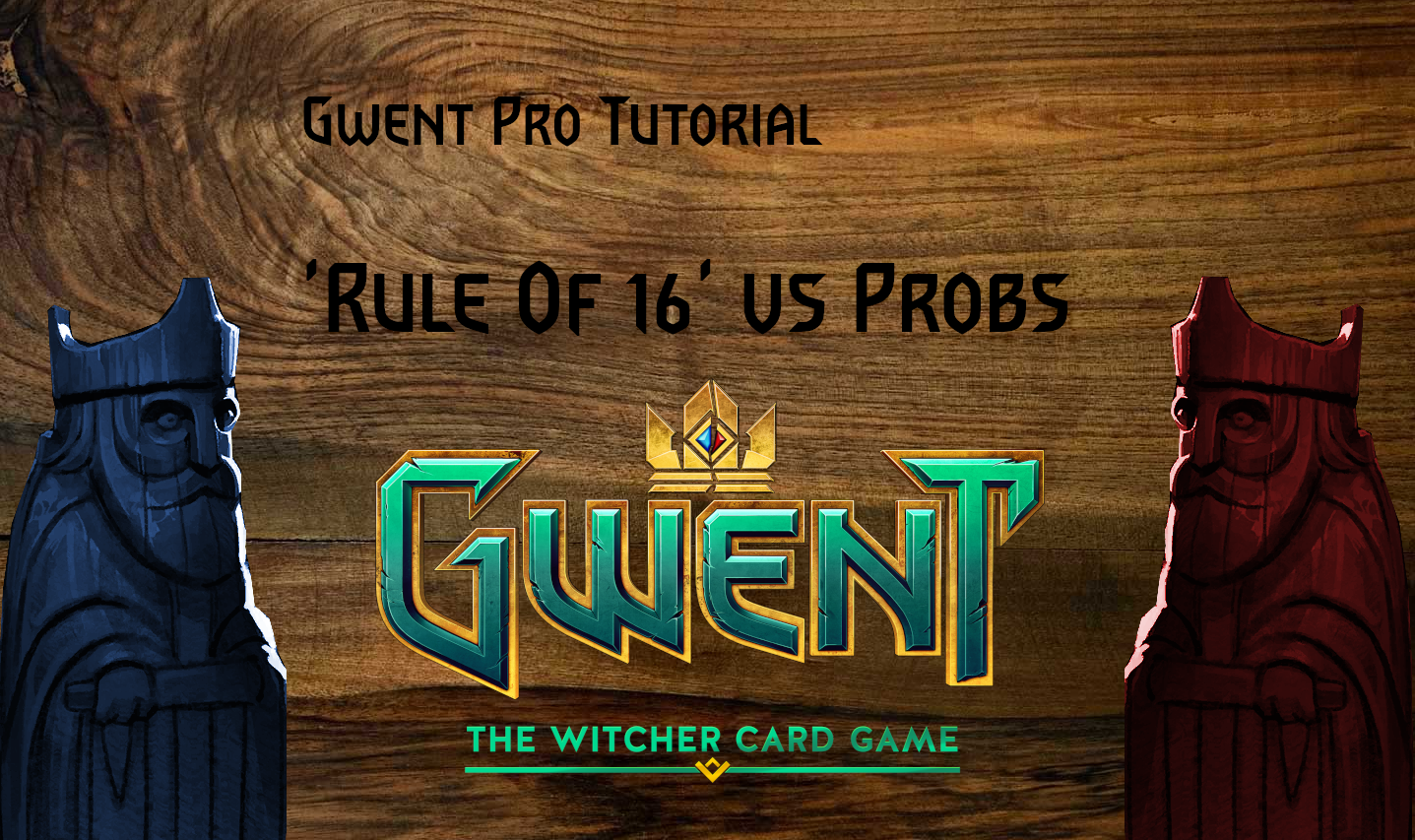Introduction
‘The Rule of 16’ along with the Execution and Preparation Teams extension (preceeding article) leads to many questions of probability nature. How often the set of 16 perfect cards is found in a game of Gwent? How often Preparation and Execution Teams are found at their respective stages of gameplay?
After a long break in this article we would revisit card drawing probabilities in Gwent: The Witcher Card Game in the context of The Rule of 16. The objective would be to learn more about the structure of the game step-by-step.
Perfect 16
Let’s forget for a moment the split of the cards according to their purpose (ET+PT) and go back to basic Rule Of 16. Let’s assume the cards are perfectly interchangable (a pointslam deck without payoffs and finishers would resemble this model most closely). What is the chance to play exactly 16 best cards during the game?

(the dashed line indicates expected value)
As could be seen, even under such indulgent assumptions, the chances to play perfect 16 during a game are lower than 1% (~0.7%). That’s worth noting that the less cards are played during R1+R2, the greater chances to play only cards from 16. For example after 3 cards R1 and 1 card R2, only 14 perfect cards are needed rather than 16. The point to be made here is that strongly polarized decks are best suited for passive R1+R2 scenarios, as cards outside 16 are less likely to be played (a good example here is Redrame’s Double Scenario Harmony, or Elves, which often tempo pass in Round 1 with Feign Death)
Of course, the probabilities tell nothing here about the quality of missed cards; missing Renfri is not equal to missing a 5p bronze. We start from the simplest analysis though and then draw most clear cut conclusions possible. The graphs above also tell how many filler (out of best 16) cards should be expected on each game stage. In Round 1 on average it would be 2 fillers and the variance is rather high – having 4 fillers happens in about 10% of games.
On average, in R2 you would gain a bit less than 3 new target cards and in R3 a bit more than 2. The more Top16 cards you already have, the harder it is to improve the hand. Getting ‘a bit less than 3’ means that each filler present in hand would on average remain there; all mulligans would effectively be used on improving topdecked cards. In a 16 cards game, if not playing fillers from hand, the average hand quality would only decrease (assuming that earlier draws were average, and the power of Top16 cards is about even).
Perfect 10 (Execution Team)
The ‘Perfect 16’ analysis in spite of some interesting general conclusions is rather abstract. Looking at draws Gwent players most often think in the category of golds and perfect R3 hand, rather than 16 cards with mixed purpose and very mixed power. Let’s move one step further then: how often perfect Execution Team is completed at various stages?

The chances to find a single card during a game are with good approximation equal to 80% without thinning and no wonder the ET becomes 80% complete in R3 (if you are curious about thinning impact, have a look at GM&P5; if you wonder how it translates to hand power disparity of two players in R3 – here is a short article). On average 2 filler cards would have to be played, while 3 is also pretty common – would happen in every 5th game. In ~7% of games you could hope for a perfect R3 hand.
The necessity to mulligan out one of ET cards in R1 happens rarely and could be neglected for practical purposes. The chance to regain a mulled out card is equal to ~60% and the intake of new ET cards each round is smaller than 2 on average for normal R1 draws.
The expected number of ET cards in R1 is 5, with highly variant, symmetrical distribution (to find out the origins of symmetry, have a look at GM&P4). As mulling out ET cards is in a sense negative carryover value, we could see the first direct symptom of why ET/PT pivot cards give more flexibility. Decks with rigid Teams would often struggle whenever forced to go down to less than 5 cards in R1. This effect usually occurs in combo decks. A Gwent 10.9 meta example would be Koshchey deck, where commiting Caranthir/Sir Scratch-A-Lot/Koshchey/Ozzrel in R1 is very suboptimal.
The rest of R1 hand shall be filled exclusively with PT cards – at least 6 PT-type cards in R1 should be accessible with good repeatability; player would decide how many of them to keep in every particular matchup. Consequently, PT team with replacements should be much larger than just 6 cards. If you look at bronzes in meta decks, you could very rarely see long round payoff cards. That’s one of the reasons – bronze cards are mostly used in PT and as PT replacements. Getting value comparable with a ET card is not easy for a cheap bronze. We would return to optimal size topic later in the article.
Finally we could see that about 3 or 4 members of ET would be missing in R2. The variance should considered in the context of R2 push. This phase is troublesome when it comes to disparity; even 3 golds difference is not uncommon. From deckbuilding point of view, we wonder how repetable the push will be. If the push would rely on strong golden opener engine, then in above 30% of cases this card would be missing (only 10% with tutor). If pushing in spite of the miss, then in short R3 this engine would lose a ton of value. Current meta examples (Gwent 10.9) are Knights and Guerilla Harmony when facing Golden Nekker Syndicate. Missing Scenario in R2 after won R1 puts these decks in an awkard position. R2 push circumstances would favor decks which main instant value cards in ET due to shorter round and better topdecks (common technique, now used for example in Renfri Vampires deck).
Perfect 6 (Preparation Team)

(Round2 and Round3 pictures will not be discussed)
As we could see, finding perfect 6 in R1 is almost impossible (<1%). If specific cards from preparation team are very important for the deck to work (for example in Renfri Gang Spam deck), multiple tutors are needed. Further analysis is not needed – use most of your 9 fillers to support PT with multiple replacements.
Optimal Team Size
Just a reminder that we are on theory grounds – try to understand reasoning behind and apply this reasoning to your practical problems. Do not follow the theorems in a strict way, especially if you do not agree with them.
Preparation Team should provide just enough cards at the early stage to setup the game for Execution Team – no less, no more. On average there would be 3 main PT cards available in R1, but the number is very variant. About 5 PT cards should be guaranteed in R1, and finding the 6th one in R2 is then no problem due to pool size.
12 PT-oriented cards would put average accessibility on 6 in R1, which should be very safe and flexible. Then 13 ET-oriented cards are left, which elevates average R3 accesibility slightly above 10. Feel free to go down a bit with the number of PT replacements to gain better R3 topdecks.
- Execution Team: 10 cards with best sequence value; 3 replacements
- Preparation Team: 6 cards best setting up ET strategy as early plays; 6 replacements
Closure
Thanks for reading! I bet this follow-up article was a harder lecture than preceeding one. Hope it inspired you to revisit the deckbuilder and try to build up something new according to presented ideas (although meta right now seems lit). Most important though is fun and I believe a well-balanced deck could bring it. Stay tuned!

